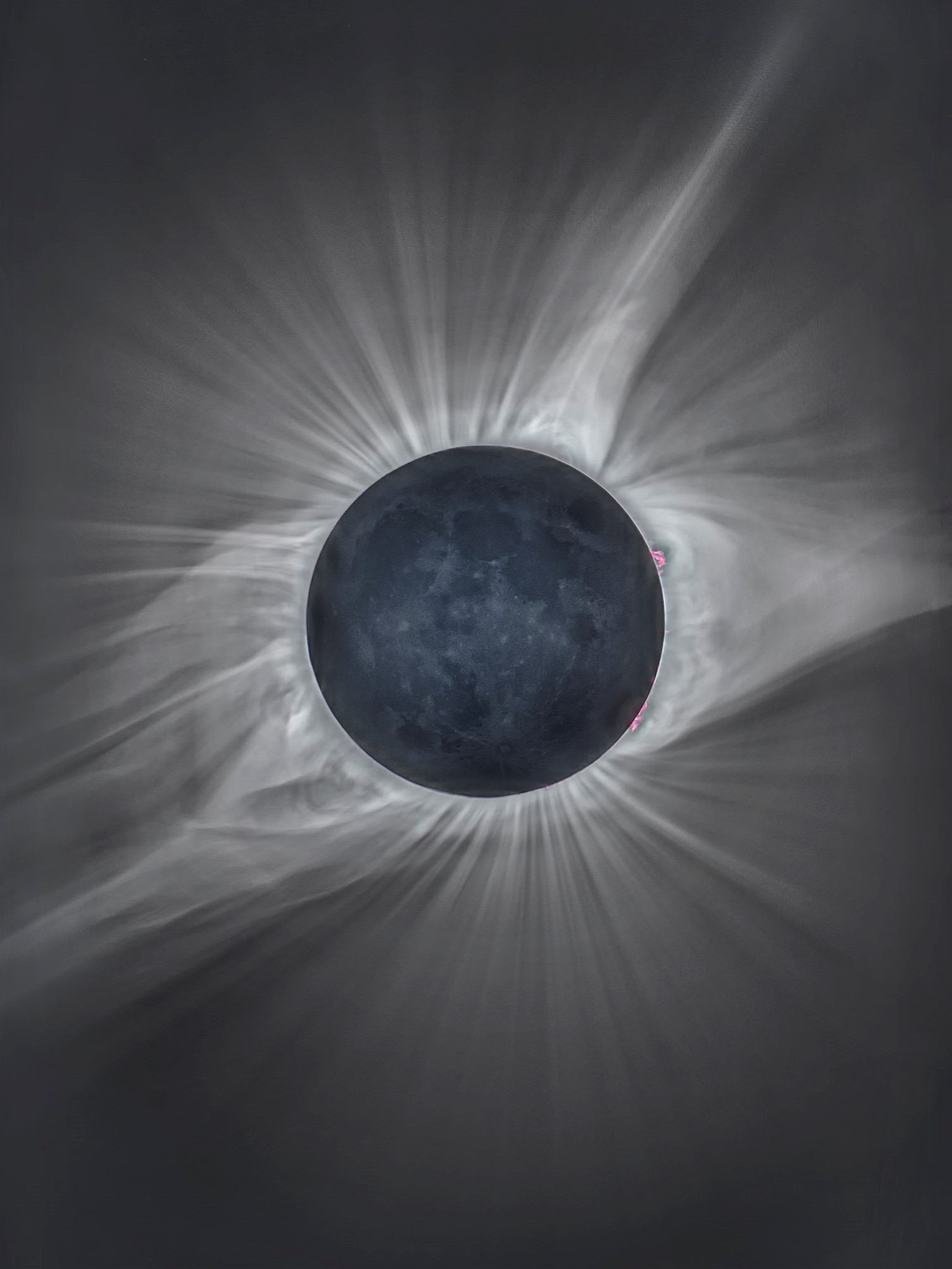
Credit: Michael S Adler, CC BY-SA 4.0, via Wikimedia Commons
A total eclipse of the Sun is a special occurrence.
The last time that the Sun and Moon lined up perfectly for a total eclipse traversing the U.S. was in 2017; another one is due on April 8, 2024, crossing the country from Texas to Maine.
While millions of Americans gaze at the sky in wonder, scientists will be hard at work.
Because a total eclipse—by blocking the Sun itself—gives us the rare chance to study its corona, the fiery heated “atmosphere” around it, from within the path of totality.
And there are still many mysteries to unravel.
For instance, the surface temperature of the Sun is 5,500 degrees centigrade. Yet the corona is far hotter, up to 20 million degrees. How could this be possible?
One study will fly a NASA high-altitude research plane along the path of the eclipse, using spectrometers and high-resolution infrared cameras to record the temperature, structure and chemical composition of the corona—and of coronal mass ejections, or solar flares—to increase our understanding of the solar winds that reach Earth and affect our weather.
And NASA needs your help. Visit the NASA website and download the SunSketcher 2024 app. They’re hoping thousands of Americans will take photos of the total eclipse with their phones, which NASA will process and add to its study. With that simple action, you’ll become a citizen scientist.
Background
Synopsis: On April 8, 2024, an eclipse will cross the continental United States from Texas to Maine. It has been seven years since the “Great American Eclipse” of 2017, when the Moon cast a shadow on Earth that raced from Oregon to South Carolina, watched by around 216 million Americans in person or online. Data was collected by a variety of means, revealing surprises about both the Sun and Earth. What will scientists be looking for during the Great American Eclipse of 2024?
- Total solar eclipses have provided scientists with special opportunities to view the mysteries of our star for centuries. And more recently, the consequences of changes to Earth’s surface and atmosphere when that star’s glow is extinguished, even briefly.

More than 5,000 people gathered on the Oregon State University campus on August 21, 2017, to watch the solar eclipse.
Credit: Oregon State University, CC BY-SA 2.0, via Wikimedia Commons- At this special time in Earth’s history, we enjoy a cosmic coincidence that makes total solar eclipses possible: the Sun and Moon seem to be about the same size in our sky. The Sun has a diameter about 400 times larger than that of the Moon, and the Moon is about 400 times closer to Earth than the Sun, sometimes enabling the Moon to almost exactly cover the bright disc of the Sun to reveal its corona.
- Solar eclipses only happen during a new moon as the Moon passes between the Sun and Earth, casting its shadow on our planet. (Lunar eclipses happen only during a full moon if Earth is situated between the Sun and Moon so that Earth casts its shadow on the Moon.)
- Since the Moon’s orbit is tilted relative to Earth’s by about 5 degrees, total eclipses only happen when the elliptical orbits of the Moon and Earth are perfectly aligned, once about every 18 months, somewhere on Earth’s surface.
- For more about how eclipses form, see ED-016 Total Eclipse of the Sun - 8/21/17.
- On Earth, scientists have used coronagraphs that block out light from the Sun to view the outer corona since the 1930s, but these instruments can’t reveal the mysterious processes that occur close to the Sun’s surface, the photosphere.
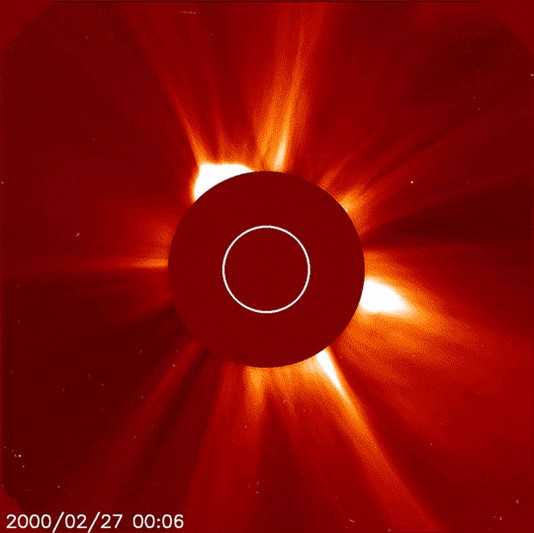
NASA’s Solar and Heliospheric Observatory, or SOHO, constantly observes the outer regions of the Sun’s corona using a coronagraph but can’t image the area closest to the Sun. That’s where eclipse observations fill in.
Credit: ESA/NASA/SOHO
- During total eclipses, scientists study the Sun and its earth connection using a variety of data collection techniques.
- To observe the Sun during an eclipse, scientists may use observatories, high-altitude airplane flights, weather balloons, and citizen-science-connected telescopes and ham radio experiments.
- To observe Earth and its atmosphere while the Sun’s power is occluded, researchers may employ satellites, the space station, citizen science networks and surface-based observations.
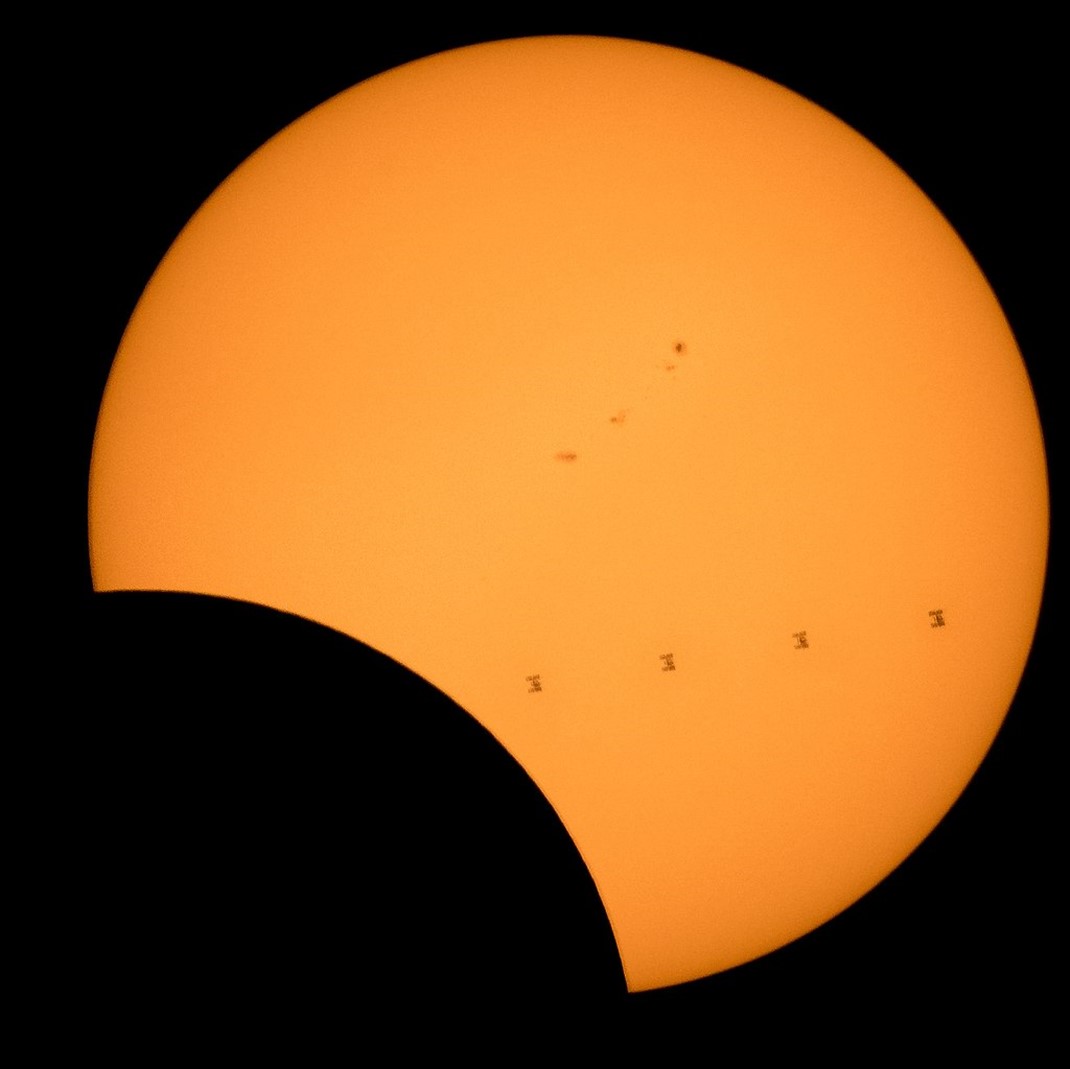
This NASA photograph is a composite, made from seven frames, that shows the International Space Station (ISS) as it transited the Sun at roughly 5 miles (8 kilometers) per second during the eclipse of August 21, 2017, as observed from Banner, Wyoming.
Credit: NASA, public domain, via Wikimedia Commons
- In 2017, NASA supported 11 experiments related to the eclipse: 6 concerned with the Sun’s atmosphere and 5 concerned with impacts on Earth and its atmosphere.
- Key solar experiments focused on corona structure and dynamics, temperature and composition and magnetic field via polarization of light.
- Other experiments concentrated on solar flares, solar wind and space weather.
- Earthly experiments looked at changes to our ionosphere as well as the effects of sudden darkness and changes in light levels on plants, animals and their behavior during the event.
- Key conclusions from 2017 experiment include the following:
- The biggest solar mystery of all concerns the temperature profile of the Sun’s layered atmosphere: while the solar surface blazes at around 5,726°C (6,000 K, 10,340°F), the more distant corona rages at up to twenty 20 million degrees Kelvin. While theories from decades ago suggest magnetic plasma waves (Alfvén waves) skip over the Sun’s surface along magnetic field lines to transport heat to its corona, more work is needed to figure out the specifics of how this works, using both observations from future eclipses and from the Parker Solar Probe. Experiments during the 2017 event raised more new questions than they answered.
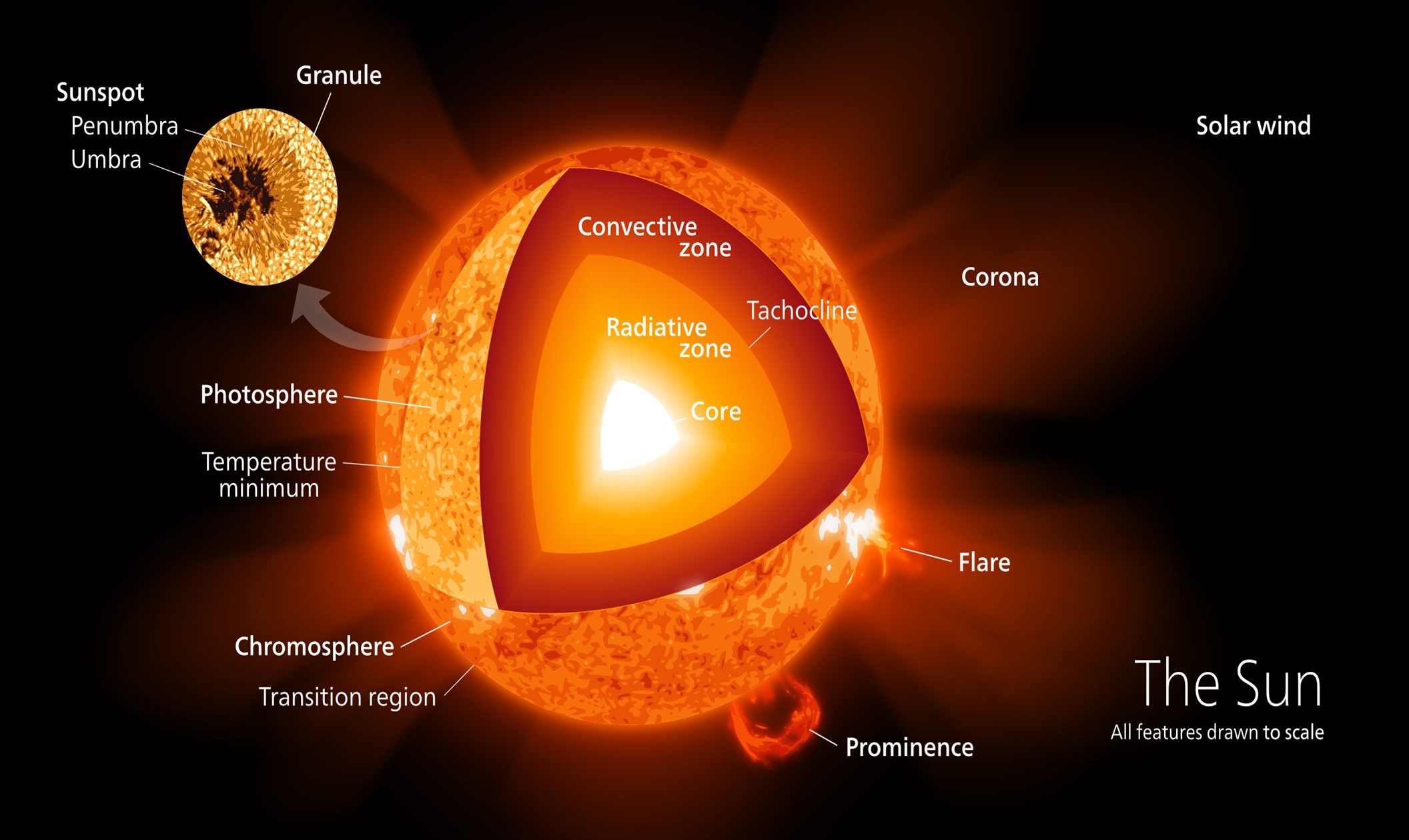
Anatomy of our Sun. Like Earth, the Sun is layered, and so is its atmosphere. Its bright surface is called the photosphere (6000 K), and above that are the chromosphere (up to 20,000 K), the transition region (up to 1,000,000 K), the corona (8-20 million K) that produces the solar wind and the undulating heliosphere through which the solar wind flows continuously away from the star.
Credit: Kelvinsong, CC BY-SA 3.0, via Wikimedia Commons - Scientists were able to image the Sun’s corona in infrared energy in two separate experiments, and coordinating with observations from the ground in Casper, Wyoming, they showed the wavelengths have sufficient amplitude to be observed in more detail by a new Hawaiian telescope currently under construction. It appears that infrared may be used to measure and map the corona’s magnetic field, which controls much of its behavior but has never been documented.
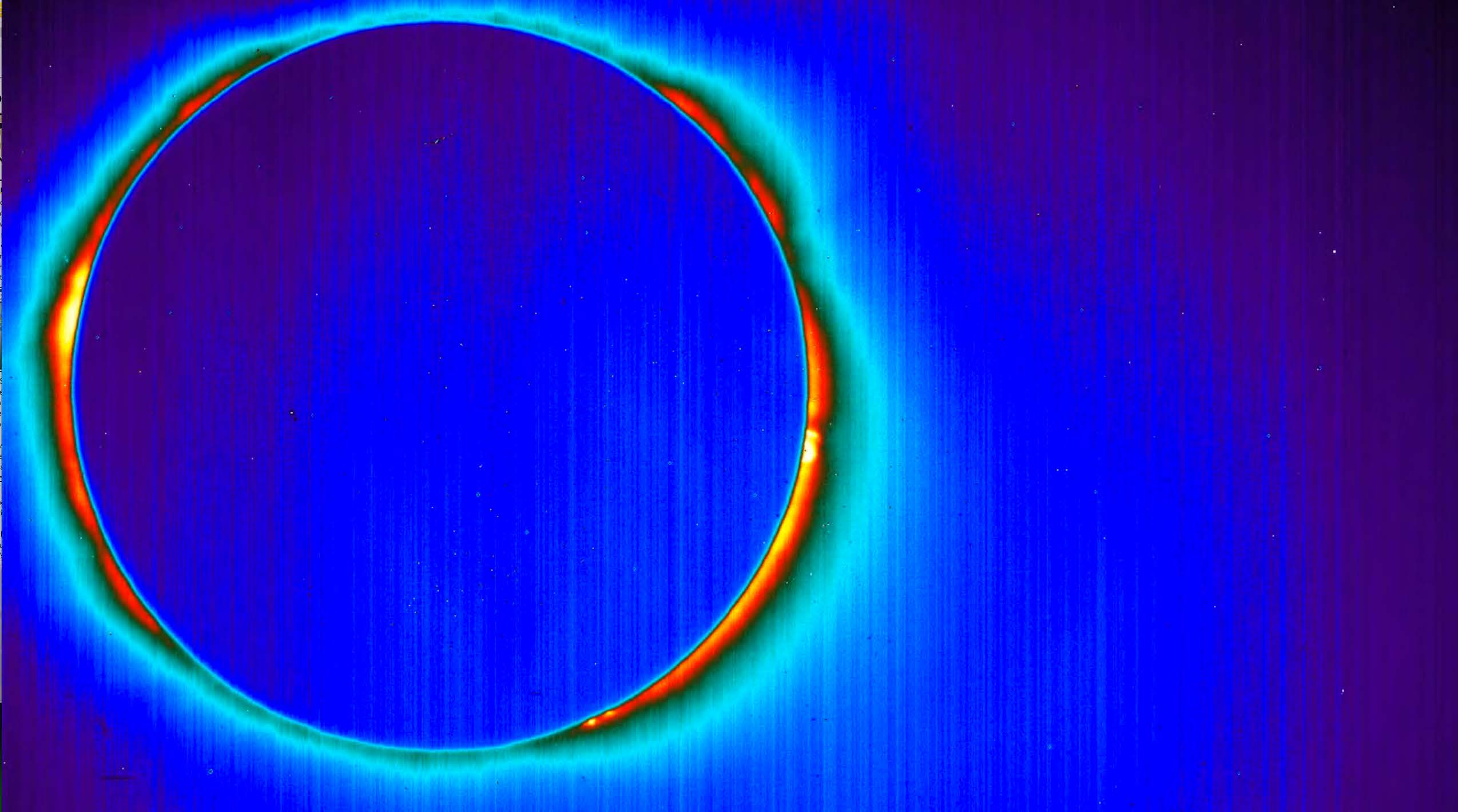
The first infrared image of the entire solar corona was taken during the eclipse in 2017. Future telescopes may use infrared wavelengths to measure the corona’s magnetic field.
Credit: NASA, SWRI, Southern Research - Einstein predicted that during an eclipse, the Sun’s mass should warp spacetime enough to shift the apparent positions of stars. In 1919 Arthur Eddington took photos that appeared to prove the prediction was correct, and in 2017 Bradley Schaefer of Louisiana State University used modern equipment that supported the prediction and experimental results, but other astrophysicists haven’t been able to replicate the result, so the question is still open.
- The Moon’s shadow produced a bow wave of electrons rejoining their atoms in Earth’s ionosphere and sent another wave through its thermosphere.
- Measurements of temperature, wind speed and Sun intensity showed that the eclipse changed weather along its path.
- The biggest solar mystery of all concerns the temperature profile of the Sun’s layered atmosphere: while the solar surface blazes at around 5,726°C (6,000 K, 10,340°F), the more distant corona rages at up to twenty 20 million degrees Kelvin. While theories from decades ago suggest magnetic plasma waves (Alfvén waves) skip over the Sun’s surface along magnetic field lines to transport heat to its corona, more work is needed to figure out the specifics of how this works, using both observations from future eclipses and from the Parker Solar Probe. Experiments during the 2017 event raised more new questions than they answered.
- Scientists will get another chance to answer some of the fundamental questions about our star on April 8, 2024, when a total eclipse will cross the United States once again. The heliophysics division of NASA has selected five experiments that use a variety of instruments for the 2024 eclipse.
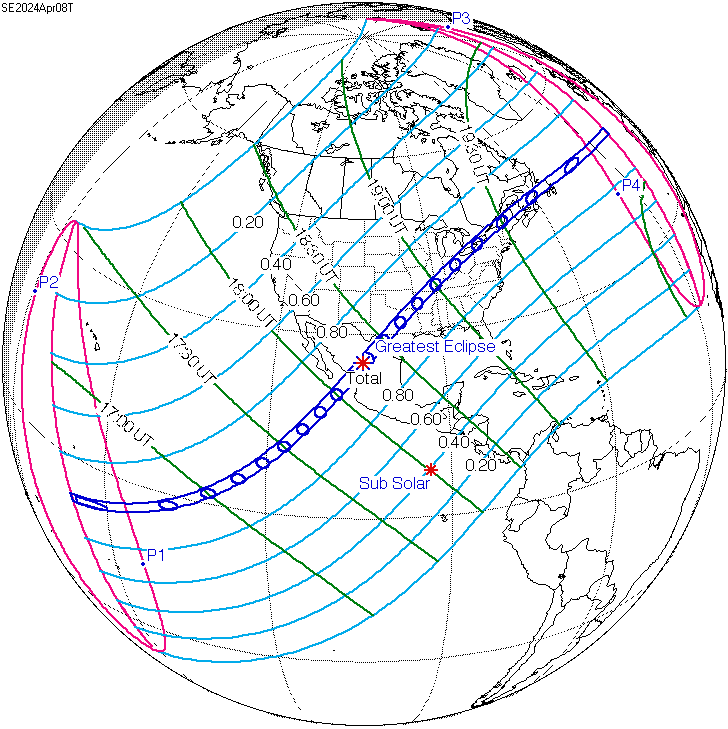
On April 8, 2024, the Moon’s shadow will enter Mexico at Mazatlán, then it will travel northeast through Mexico, entering the United States at Eagle Pass, Texas. From Texas it will take a diagonal path across 11 other states to Maine, finally crossing the maritime provinces of Canada. The blue pair of lines shows the path of totality, while cyan curves parallel to path of totality mark the degree of maximum partial eclipse. Green lines show times of greatest eclipse in UTC (subtract four hours to get Eastern Daylight Savings time) as the shadow sweeps across the country.
Credit: Eclipse Predictions by Fred Espenak, NASA's GSFC, public domain, via Wikimedia Commons- One experiment will use NASA’s WB-57 high-altitude research aircraft to chase the eclipse above most of Earth’s atmosphere at 50,000 ft (15,000 m), taking infrared and visible-light images of the corona at high speed and resolution.

A WB-57F jet is readied for a test run at NASA’s Johnson Space Center in Houston.
Credit: NASA’s Johnson Space Center/Norah Moran - The cameras and spectrometers on the WB-57 will also capture details of the temperature, structure, and chemical composition of both the corona and coronal mass ejections and increase our understanding of the solar wind that is generated by the corona.
- Ham radios and citizen scientists will participate in a “listening party” to further document variations in radio wave transmission through Earth’s ionosphere during eclipses, which have been previously noted.
- Another experiment will monitor the effects of solar radiation on space weather in Earth’s upper atmosphere.
- Finally, citizen scientists will assist researchers as they bring magnetically complex regions over sunspots known as “active regions” into better focus by observing them as the Moon slowly passes over them, accentuating the active regions’ light and radio emissions.
- One experiment will use NASA’s WB-57 high-altitude research aircraft to chase the eclipse above most of Earth’s atmosphere at 50,000 ft (15,000 m), taking infrared and visible-light images of the corona at high speed and resolution.
- After the April 8, 2024, eclipse, the next eclipses that will cross over the contiguous United States are two decades away, on August 23, 2044, and August 12, 2045.
- Remember to never look directly at the Sun with binoculars, a telescope, or your eyes. Use special filters to protect your eyes like astronomers do.

